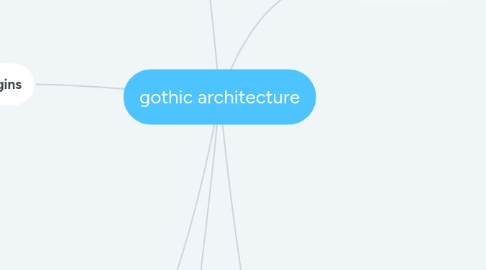
1. Definitions
1.1. Style of fiction that emphasizes the grotesque, mysterious, and desolate
1.2. Term given to this period by the Renaissance, describing a culture that was considered rude and barbaric
1.3. It came to be applied to the architectural styles of northern Europe
2. Origins
2.1. Began in mid-12th century, in a French province called Ile de France
2.2. Started by an architect named Abbot Suger – rebuilt the Royal Abbey Church of St. Denis between the years of 1137 and 1144
2.3. Brought together a number of improvements in late Romanesque church architecture – pointed arches and rib vaulting
2.4. Created a lighter & more visually transparent architecture
2.5. Replace wall of stone with wall of stained glass which filtered & transformed sunlight so that it symbolized divine illumination
2.6. An ancient document describes God as the ‘superessential light’, - the ‘Father of Light’.
2.7. Coincided with the rise of theology (Thomas Aquinas)
3. Architecture
3.1. The focus of human action remained religious life
3.2. Gothic symbolised a new synthesis of Humanity, God & Nature
3.3. Gothic was a contradiction – this embrace of earthly life resulted in an architecture that so emphatically aspired to heaven
3.4. The loftiness and huge dimensions of the Gothic church were intended to pass a theological message: the great glory of God versus the smallness and insignificence of the mortal being
3.5. Essentially urban - the cathedrals were all situated in towns, rising high above the town to be seen from afar
4. Concept
4.1. Mass eliminated in favour of skeletal structure
4.2. Light is seen as the divine presence
4.3. Use of the sacred geometry
4.3.1. Square
4.3.2. Circle
4.3.3. Triangle
4.4. Visual bible in built form – art for God’s sake
4.5. Vertical aspirations
5. The Middle Ages
5.1. Era between the Renaissance (15th c) and the Classical Roman Age
5.2. The middle period of the traditional division of Western history into Classical, Medieval, and Modern
5.3. 3 periods
5.3.1. Early Middle Ages 450-900
5.3.1.1. True dark age – unrest, wars; commission of public buildings nearly stopped
5.3.1.2. Building types: monastries and castles
5.3.1.3. The devil was accorded great powers, and was believed to have a rightful dominion over men – inhibited human development
5.3.2. High Middle Ages 900-1200
5.3.2.1. Cities ceased to be important, economy turned to rural agricultural estates. Gradual resumption of travel and trade
5.3.2.2. Start of the first of 8 crusades against the Muslims in the east.
5.3.2.3. Revival of building on a large scale – Romanesque and pilgrimage churches. Feudal system
5.3.3. Late Middle Ages 1200-1450
5.3.3.1. The rise of cities
5.3.3.2. Development of light and graceful Gothic architecture in church, education and private buildings.
5.3.3.3. Devastation of the Black Death
5.3.3.4. Political turmoil of the Hundred Years War.
6. Features
6.1. verticality
6.2. skeletal stone structures
6.3. great expanses of glass
6.4. sharply pointed spires
6.5. cluster columns
6.6. flying buttresses
6.6.1. structural feature used to transmit the thrust of a vault across an intervening space to a buttress built outside the latter.
6.6.2. The employment of the flying buttress means that the load bearing walls can contain cut-outs, such as for large windows, that would otherwise seriously weaken the vault walls.
6.7. ribbed vaults
6.8. pointed arches
6.9. inventive sculptural detail.
6.10. Light and airy
6.10.1. light is seen as the divine presence – the skeletal structure allowed for the solid walls to convert to a wall of glass. Large stained-glass windows allowed much light to enter

